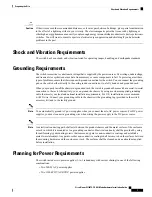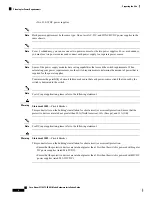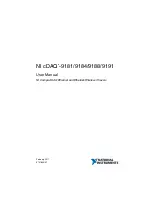
• Ensure that you are positioning the switch in a rack so that it takes in cold air from the cold aisle and
exhausts air to the hot aisle. If there is blue coloring on the fan modules, the switch is configured for
port-side exhaust airflow and you must position the module side of the switch in a cold aisle. If there is
burgundy coloring on the fan modules, the switch is configured for port-side intake airflow and you must
position the port side of the switch in a cold aisle.
• Ensure that the chassis can be adequately grounded. If the switch is not mounted in a grounded rack, we
recommend connecting the system ground on the chassis directly to an earth ground.
• Ensure that the site power meets the power requirements for the switch. If available, you can use an
uninterruptible power supply (UPS) to protect against power failures.
Avoid UPS types that use ferroresonant technology. These UPS types
can become unstable with the switch, which can have substantial
current draw fluctuations because of fluctuating data traffic patterns.
Caution
• Ensure that circuits are sized according to local and national codes. Typically, this often requires one or
both of the following:
• AC power supplies typically require at least a 15-A or 20-A AC circuit, 100 to 240 VAC, and a
frequency of 50 to 60 Hz.
To prevent loss of input power, ensure the total maximum loads on
the circuits supplying power to the switch are within the current
ratings for the wiring and breakers.
Caution
For AC input application, please refer to the statement below:
Note
Statement 1005—
Circuit Breaker
This product relies on the building's installation for short-circuit
(overcurrent) protection. Ensure that the protective devices is rated
not greater than 20A (North America), 16A (Europe), and 13A (UK).
Warning
For DC input application, please refer to the statement below:
Note
Cisco Nexus 93108TC-FX ACI Mode Hardware Installation Guide
15
Installing the Switch Chassis
Installation Guidelines






































